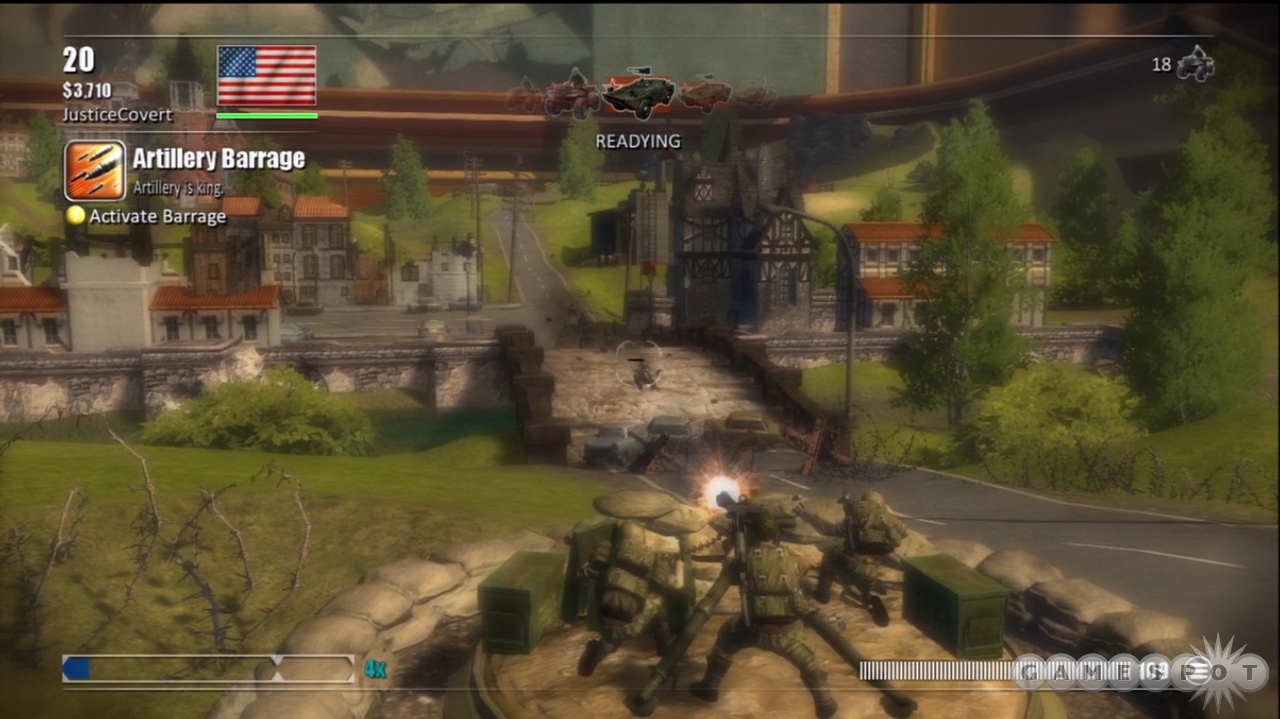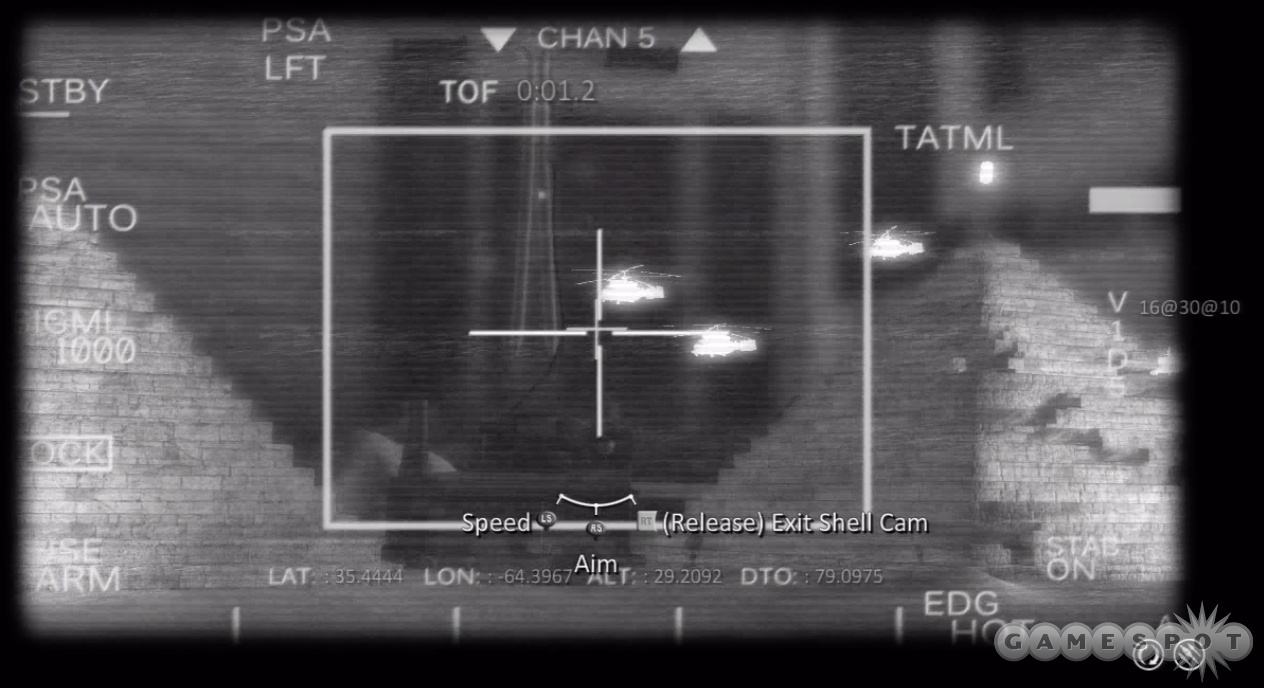History tells us that in the 40-plus years of the Cold War, forces from the United States and Soviet Union never actually faced each other in a major battle. The story is very different in the Toy Soldiers universe, though, where the opposing superpowers go head-to-head on battlefield dioramas across the world. Like its predecessor, Toy Soldiers: Cold War is a tower defense game in which quick reflexes are often as important as strategic thinking. You defend your toy box base not only by setting up gun emplacements, but also by manning said emplacements and, where they're available, taking direct control of vehicles and commando units that are powerful enough to turn the tide of a battle. Commando action figures are a great addition to the original Toy Soldiers formula, and Cold War makes plenty of smart improvements elsewhere as well; new kill combos offer significant gameplay rewards, minigames let you hone important skills outside of battle, a new rewind feature lets you correct costly mistakes during campaign missions, and cooperative play (online or split-screen) is now an option in both the Campaign and Survival modes. You get a formidable arsenal of toys to play with for your 1200 Microsoft points, and you won't want to put them away until long after you've ensured victory for the US.
Where the original Toy Soldiers campaign afforded you an opportunity to play through World War I from the perspectives of both the Allies and the Central Powers, in Cold War you play only as the US. The 11 missions typically take 20 to 30 minutes each to play through, but that certainly doesn't mean that you can expect to be done with the game in five hours. For starters, you're unlikely to beat all of the missions on your first attempt; the default difficulty setting isn't overly challenging, but you unlock new turrets and vehicles (and face new enemies) as you progress, and it can take a while to figure out their respective strengths and weaknesses. You're also likely to play through missions more than once, and not only because you want to improve your scores on the leaderboards.
When you finish a level, you're awarded medals based on how many enemies made it past your defenses, how much money you finished the level with, and how much time you saved by manually triggering enemy waves prematurely. Score three gold medals, and you earn yourself a platinum grade, which is no mean feat. Furthermore, there are two decorations to unlock in each level that encourage you to mix up your play style. You might be required to destroy fast-moving ATVs using artillery, kill 100 units while using a helicopter's night vision, or torch infantry by dropping napalm on them from your F-14 Tomcat. Replaying levels in Cold War is never dull because there are so many different ways to approach them. There are also five difficulty levels to choose from, which, in addition to the requisite easy, normal, and hard settings, include two that change the gameplay significantly. Elite mode, which is carried over from the first game, prevents your defensive emplacements from firing automatically, so the game almost turns into a turret-based shooter. The new General mode does the opposite: emplacements can't be commandeered, so after positioning them on the map, you're at the mercy of the mostly smart AI soldiers that are manning them. Both are a lot of fun and pose a significant challenge.

Regardless of which difficulty level you choose, your goal in Cold War is always the same: to prevent enemy units that attack in distinct waves from reaching your toy box. You do this by building defensive emplacements in predetermined locations that come in two sizes. Small build points can only accommodate machine guns, antitank guns, mortars, and "makeshift" weapons that include flamethrowers fashioned from upturned aerosol cans and the like. Large build points can also accommodate heavy artillery and antiair guns. All of these defenses and their respective upgrades cost money, and the only way to earn money is to kill enemies. At all times you can see which units the next couple of enemy waves are going to be composed of, so the challenge is to prepare for impending threats while dealing with current ones. Build too many machine guns when confronted by a massive wave of infantry, and you might struggle to deal with the tanks that arrive 30 seconds later. Place powerful artillery cannons on both of your large build points to combat enemy tanks, and the next wave's aircraft are going to fly into your toy box largely unchallenged. You always have the option to sell off emplacements that are no longer useful, but you get back only a fraction of the money that you spent building and upgrading them.
Upgrades are interesting in Toy Soldiers: Cold War because while they invariably make your defenses more powerful, they don't always make them better for your current situation. For example, when you upgrade a level 1 antitank gun to level 2, its rate of fire increases dramatically, but when you man the gun yourself, you no longer have the option to take control of the projectiles and steer them around obstacles toward targets. And when you upgrade a level 1 antiair gun, its rate of fire decreases but it gains the ability to lock onto targets, which is vital when you're being attacked by speedy MiG fighters but might not be up to the task if you have an armada of Mi-24 Hind helicopter gunships hovering above. Less-than-ideal emplacements can be made to work if you man them yourself (your AI soldiers let enemies get relatively close before attacking and certainly aren't creative enough to, say, use antitank rounds against a helicopter), but there's only so much that you can do manning one turret on a battlefield, and while you're focusing on that, you're not managing upgrades and repairs elsewhere.

There's very little downtime during battles, and what's great is that even at times when you could conceivably catch your breath and let your turrets do the work, you're encouraged to get involved. Destroy an enemy unit with a manually guided projectile at high speed, and you can earn extra money in the form of a "thrill ride" bonus, and if you manage to string together a combo of at least 40 kills or take down an enemy with a red star icon above it, you gain access to a randomly selected "barrage" ability.
Barrages, which include the aforementioned commando unit, are powerful, onetime-use abilities that, once earned, can be held onto until you really need them. As the Rambo-like commando, who drops onto the battlefield still in his mint-condition packaging, you're armed with both a machine gun and a bazooka and therefore can make short work of just about any enemy unit that crosses your path. You have to tolerate listening to the commando spouting the same few Stallone catchphrases ad nauseam for the minute or so that you control him on the battlefield, but it's a small price to pay given how incredibly effective he is. Other, equally effective barrages include artillery fire across a large area, a bombing run that you can call in with some precision, a nuclear strike that destroys any enemies close to ground zero, and a chance to man the guns on an AC-130 ground-attack aircraft circling high above the battlefield. (Reminiscent of the AC-130 sequence in Call of Duty 4: Modern Warfare, this "close air support" barrage employs night vision to highlight your enemies and even lets you switch between three guns of different sizes.)
It's possible to earn barrages in all of Cold War's campaign levels, but the opportunities to do so don't come along very often. The levels themselves offer plenty of variety and incorporate diminutive re-creations of the Egyptian pyramids, the Eiffel Tower, and Mount Rushmore. Gameplay variety comes courtesy of the new defensive options, barrages, and enemies that show up as you progress, as well as from a trio of memorable bosses that look like the sorts of toys only the wealthiest kid in school could ever hope to own. Odds are that kid wouldn't have let you play with them, but that's OK; while he's playing solo with his giant biplane tank, you and a friend can have a great time either cooperating or competing with your regular-sized toys.
Cooperative play works well in both the campaign and Survival mode missions. In both, the two of you are responsible for earning and managing your own pool of money, so if you're hogging all of the action and gunning down enemy troops, you need to be aware that your partner might not have the necessary funds to keep your shared turrets up and running. The three survival missions play out in much the same way that campaign missions do; the main difference is that they don't end until your toy box has been overwhelmed. It's not too difficult to keep a survival mission running for 30 minutes to an hour (at least on the default difficulty setting), so it's unfortunate that it's not possible to save your progress mid-mission the same way that you now can during campaign missions.

If competitive play is more your scene, you might find Cold War's Versus mode extremely hard to put down. The cheap tactics that worked in the original Toy Soldiers (manually flying planes at full speed into the enemy's toy box) no longer work, and all of the three maps incorporate one or more contested build points that you have to capture using your commando unit (if you're playing as the Soviet Union you get a clone of Ivan Drago from Rocky IV) before you can place defenses on them. Balancing your time and money between the same defensive duties that you have in other modes and triggering offensive waves of your choosing is a lot of fun, in part because human opponents are far less predictable than the AI.
There's a great deal of strategy involved; you can't win by just sitting back and defending, but at the same time it's risky to commit too many of your resources to an offensive because killing your attacking units is a quick way for your opponent to accumulate money. Versus games can be customized in a number of ways: vehicles and barrages can be disabled completely; turrets can be switched to Elite mode; and you can change both the toy boxes' health and the amount of cash that each player gets depending on the length of game that you're looking to play. The only noteworthy disappointment where Versus mode is concerned is that the Versus leaderboards make no distinction between games played against random online opponents and games played with friends online or even in split-screen. As a result, the Versus mode leaderboard is far too easy to game and isn't nearly as compelling as the leaderboards for other modes.

Elsewhere, Toy Soldiers: Cold War is a difficult game to find fault with. The frame rate nose-dives occasionally when the screen is filled with units and explosions, but this problem is infrequent and rarely lasts for more than a few seconds. Toy Soldiers: Cold War improves upon its already great predecessor in just about every way. Where the original game succeeded in evoking World War I with charming old tunes, a muted color palette, and a world beyond the battlefield that incorporated antique radios and the like, this game evokes the '80s period of the Cold War with a Top Gun-inspired soundtrack, bright colors, and a smattering of references to cheesy movies of the time. Playing with toy soldiers in real life demands a great deal of your imagination and involves a lot of tidying up afterward. Toy Soldiers: Cold War does all of the work for you and makes those spectacular battles that you remember fighting on your bedroom floor as a child come to life.



